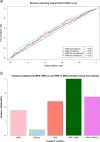Epigenetic prediction of major depressive disorder
- PMID: 32523041
- PMCID: PMC8589651
- DOI: 10.1038/s41380-020-0808-3
Epigenetic prediction of major depressive disorder
Abstract
Variation in DNA methylation (DNAm) is associated with lifestyle factors such as smoking and body mass index (BMI) but there has been little research exploring its ability to identify individuals with major depressive disorder (MDD). Using penalised regression on genome-wide CpG methylation, we tested whether DNAm risk scores (MRS), trained on 1223 MDD cases and 1824 controls, could discriminate between cases (n = 363) and controls (n = 1417) in an independent sample, comparing their predictive accuracy to polygenic risk scores (PRS). The MRS explained 1.75% of the variance in MDD (β = 0.338, p = 1.17 × 10-7) and remained associated after adjustment for lifestyle factors (β = 0.219, p = 0.001, R2 = 0.68%). When modelled alongside PRS (β = 0.384, p = 4.69 × 10-9) the MRS remained associated with MDD (β = 0.327, p = 5.66 × 10-7). The MRS was also associated with incident cases of MDD who were well at recruitment but went on to develop MDD at a later assessment (β = 0.193, p = 0.016, R2 = 0.52%). Heritability analyses found additive genetic effects explained 22% of variance in the MRS, with a further 19% explained by pedigree-associated genetic effects and 16% by the shared couple environment. Smoking status was also strongly associated with MRS (β = 0.440, p ≤ 2 × 10-16). After removing smokers from the training set, the MRS strongly associated with BMI (β = 0.053, p = 0.021). We tested the association of MRS with 61 behavioural phenotypes and found that whilst PRS were associated with psychosocial and mental health phenotypes, MRS were more strongly associated with lifestyle and sociodemographic factors. DNAm-based risk scores of MDD significantly discriminated MDD cases from controls in an independent dataset and may represent an archive of exposures to lifestyle factors that are relevant to the prediction of MDD.
© 2020. The Author(s).
Conflict of interest statement
AMM has received grant support from Pfizer, Eli Lilly, Janssen and The Sackler Trust. These sources are not connected to the current investigation. AMM has also received speaker fees from Janssen and Illumina. The remaining authors report no conflicts of interest.
Figures



References
-
- Depression WH. Other common mental disorders: global health estimates. Geneva: World Health Organization; 2017:1–24.
Publication types
MeSH terms
Grants and funding
LinkOut - more resources
Full Text Sources

